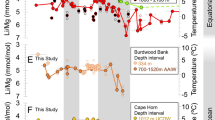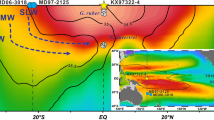Abstract
The low-latitude ocean is strongly stratified by the warmth of its surface water. As a result, the great volume of the deep ocean has easiest access to the atmosphere through the polar surface ocean. In the modern polar ocean during the winter, the vertical distribution of temperature promotes overturning, with colder water over warmer, while the salinity distribution typically promotes stratification, with fresher water over saltier. However, the sensitivity of seawater density to temperature is reduced as temperature approaches the freezing point, with potential consequences for global ocean circulation under cold climates1,2. Here we present deep-sea records of biogenic opal accumulation and sedimentary nitrogen isotopic composition from the Subarctic North Pacific Ocean and the Southern Ocean. These records indicate that vertical stratification increased in both northern and southern high latitudes 2.7 million years ago, when Northern Hemisphere glaciation intensified in association with global cooling during the late Pliocene epoch. We propose that the cooling caused this increased stratification by weakening the role of temperature in polar ocean density structure so as to reduce its opposition to the stratifying effect of the vertical salinity distribution. The shift towards stratification in the polar ocean 2.7 million years ago may have increased the quantity of carbon dioxide trapped in the abyss, amplifying the global cooling.
This is a preview of subscription content, access via your institution
Access options
Subscribe to this journal
Receive 51 print issues and online access
$199.00 per year
only $3.90 per issue
Buy this article
- Purchase on Springer Link
- Instant access to full article PDF
Prices may be subject to local taxes which are calculated during checkout



Similar content being viewed by others
References
Winton, M. The effect of cold climate upon North Atlantic Deep Water formation in a simple ocean-atmosphere model. J. Clim. 10, 37–51 (1997)
Adkins, J. F., McIntyre, K. & Schrag, D. P. The salinity, temperature, and δ18O of the glacial deep ocean. Science 298, 1769–1773 (2002)
Mitchell, B. G., Brody, E. A., Holm-Hansen, O., McClain, C. & Bishop, J. Light limitation of phytoplankton biomass and macronutrient utilization in the Southern Ocean. Limnol. Oceanogr. 36, 1662–1677 (1991)
Martin, J. H. & Gordon, R. M. Northeast Pacific iron distributions in relation to phytoplankton productivity. Deep-Sea Res. 35, 177–196 (1988)
Conkright, M. E. et al. World Ocean Atlas 2001: Objective Analyses, Data Statistics, and Figures, CD-ROM Documentation (National Oceanographic Data Center, Silver Spring, 2002)
Warren, B. Why is no deep water formed in the North Pacific? J. Mar. Res. 41, 327–347 (1983)
Haug, G. H., Sigman, D. M., Tiedemann, R., Pedersen, T. F. & Sarnthein, M. Onset of permanent stratification in the subarctic Pacific Ocean. Nature 40, 779–782 (1999)
Hillenbrand, C.-D. & Fütterer, D. K. Neogene to Quaternary deposition of opal on the continental rise west of the Antarctic Peninsula, ODP Leg 178, Sites 1095, 1096 and 1101. Proc. ODP Sci. Res. 178, 1–33 (2001)
Barker, P. F. & Kennett, J. P. Weddell Sea paleoceanography: Preliminary results of ODP Leg 113. Palaeogeogr. Palaeoclimatol. Palaeoecol. 67, 75–102 (1988)
Altabet, M. A. & Francois, R. Sedimentary nitrogen isotopic ratio as a recorder for surface ocean nitrate utilization. Glob. Biogeochem. Cycles 8, 103–116 (1994)
Andreev, A., Kusakabe, M., Honda, M., Murata, A. & Saito, C. Vertical fluxes of nutrients and carbon through the halocline in the western subarctic gyre calculated by mass balance. Deep-sea Res. II 49, 5577–5593 (2002)
Narita, H. et al. Biogenic opal indicating less productive northwestern North Pacific during the glacial ages. Geophys. Res. Lett. 29, doi:10.1029/2001GL014320 (2002)
Sigman, D. M., Altabet, M. A., Francois, R., McCorkle, D. C. & Fischer, G. The δ15N of nitrate in the Southern Ocean: Consumption of nitrate in surface waters. Glob. Biogeochem. Cycles 13, 1149–1166 (1999)
Sigmon, D. E., Nelson, D. M. & Brzezinski, M. A. The Si cycle in the Pacific sector of the Southern Ocean: seasonal diatom production in the surface layer and export to the deep sea. Deep-sea Res. II 49, 1747–1763 (2002)
Brzezinski, M. A. et al. A switch from Si(OH)4 to NO3- depletion in the glacial Southern Ocean. Geophys. Res. Lett. 29, doi:10.1029/2001GL014349 (2002)
Lefevre, N. & Watson, A. J. Modeling the geochemical cycle of iron in the oceans and its impact on atmospheric CO2 concentrations. Glob. Biogeochem. Cycles 13, 727–736 (1999)
Francois, R. F. et al. Water column stratification in the Southern Ocean contributed to the lowering of glacial atmospheric CO2 . Nature 389, 929–935 (1997)
Gildor, H. & Tziperman, E. Physical mechanisms behind biogeochemical glacial-interglacial CO2 variations. Geophys. Res. Lett. 28, 2421–2424 (2001)
Boyle, E. A. & Keigwin, L. D. Deep circulation of the North Atlantic for the last 200,000 years: geochemical evidence. Science 218, 784–787 (1982)
Manabe, S. & Stouffer, R. J. Simulation of abrupt climate change induced by freshwater input to the North Atlantic Ocean. Nature 378, 165–167 (1995)
Wang, Z. M., Mysak, L. A. & McManus, J. F. Response of the thermohaline circulation to cold climates. Paleoceanography 17, doi:10.1029/2000PA000587 (2002)
Sarmiento, J. L., Hughes, T. M. C., Stouffer, R. J. & Manabe, S. Response of the ocean carbon cycle to anthropogenic climate warming. Nature 393, 245–249 (1998)
Toggweiler, J. R. Russell, J. Shifted westerlies caused low CO2 during cold glacial periods. Eos 84 (Ocean Sci. Meet. Suppl.), OS21N-06 (2003).
Sarmiento, J. L. & Toggweiler, J. R. A new model for the role of the oceans in determining atmospheric pCO2 . Nature 308, 621–624 (1984)
Froelich, P. N. et al. Biogenic opal and carbonate accumulation rates in the Subantarctic South Atlantic: The Late Neogene of Meteor Rise Site 704. Proc. ODP Sci. Res. 114, 515–532 (1991)
Orsi, A. H., Whitworth, T. III & Nowlin, W. D. Jr On the meridional extent and fronts of the Antarctic Circumpolar Current. Deep-Sea Res. I 42, 641–673 (1995)
Rea, D. K., Basov, I. A., Janecek, T. R. & Palmer-Julson, A. Introduction to Leg 145: North Pacific Transect. Proc. ODP Init. Rep. 145, 5–7 (1993)
Burckle, L. H., Gersonde, R. & Abrams, N. Late Pliocene-Pleistocene paleoclimate in the Jane Basin region: ODP Site 697. Proc. ODP Sci. Res. 113, 803–809 (1987)
Brewster, N. A. Cenozoic biogenic silica sedimentation in the Antarctic Ocean. Geol. Soc. Am. Bull. 91, 337–347 (1980)
Diekmann, B., Fälker, M. & Kuhn, G. Environmental history of the south-eastern South Atlantic since the middle Miocene: Evidence from the sedimentological records of ODP Sites 1088 and 1092. Sedimentology 50, 511–529 (2003)
Acknowledgements
This work was supported by the US NSF, Schweizer Nationalfonds, Deutsche Forschungsgemeinschaft, and by British Petroleum and Ford Motor Company through the Carbon Mitigation Initiative at Princeton University. This research used samples provided by the ODP. The ODP is sponsored by NSF and participating countries under the management of Joint Oceanographic Institutions. We thank T. F. Pedersen and K. Gordon for isotope analyses, M. Soon for analytical assistance, and C.-D. Hillenbrand for providing data from ODP Site 1096. J. D. Hays focused our attention on M. Winton's work on the climate implications of the nonlinear dependence of density on temperature. D. P. Schrag encouraged its pursuit as a general mechanism, and J. F. Adkins contributed the thoughts about the role of sea ice formation on the Antarctic shelf.
Author information
Authors and Affiliations
Corresponding author
Ethics declarations
Competing interests
The authors declare that they have no competing financial interests.
Supplementary information
Supplementary Figure 1
Evidence from ODP Site 883 in the western Subarctic North Pacific for a correlation between warm climate and high opal accumulation during the mid-Cenozoic. (PDF 123 kb)
Rights and permissions
About this article
Cite this article
Sigman, D., Jaccard, S. & Haug, G. Polar ocean stratification in a cold climate. Nature 428, 59–63 (2004). https://doi.org/10.1038/nature02357
Received:
Accepted:
Issue Date:
DOI: https://doi.org/10.1038/nature02357
This article is cited by
-
Atmospheric CO2 during the Mid-Piacenzian Warm Period and the M2 glaciation
Scientific Reports (2020)
-
Response of a comprehensive climate model to a broad range of external forcings: relevance for deep ocean ventilation and the development of late Cenozoic ice ages
Climate Dynamics (2019)
-
Palaeoclimate constraints on the impact of 2 °C anthropogenic warming and beyond
Nature Geoscience (2018)
-
Incursions of southern-sourced water into the deep North Atlantic during late Pliocene glacial intensification
Nature Geoscience (2016)
-
RETRACTED ARTICLE: Evolution and fate of chemical elements in the Earth’s crust, ocean, and atmosphere
Meccanica (2015)
Comments
By submitting a comment you agree to abide by our Terms and Community Guidelines. If you find something abusive or that does not comply with our terms or guidelines please flag it as inappropriate.



